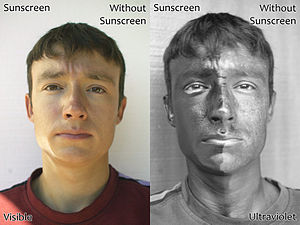Sun protection factor (SPF)
The sun protection factor of a sunscreen is a laboratory measure of the effectiveness of sunscreen — the higher the SPF, the more protection a sunscreen offers against UV-B (the ultraviolet radiation that causes sunburn).
The SPF is the amount of UV radiation required to cause sunburn on skin with the sunscreen on, relative to the amount required without the sunscreen.[8] There is a popular misconception that SPF relates to time of solar exposure. For example, many consumers believe that, if they normally get sunburn in one hour, then an SPF 15 sunscreen allows them to stay in the sun 15 hours (i.e., 15 times longer) without getting sunburn. This is not true because SPF is not directly related to time of solar exposure but to amount of solar exposure. Although solar energy amount is related to solar exposure time, there are other factors that impact the amount of solar energy, like the time of day. This is because, during early morning and late afternoon, the sun's radiation must pass through more of the Earth's atmosphere before it gets to you. In practice, the protection from a particular sunscreen depends on factors such as:
- The skin type of the user.
- The amount applied and frequency of re-application.
- Activities in which one engages (for example, swimming leads to a loss of sunscreen from the skin).
- Amount of sunscreen the skin has absorbed.
The SPF is an imperfect measure of skin damage because invisible damage and skin aging are also caused by ultraviolet type A (UVA, wavelength 320 to 400 nm), which does not cause reddening or pain. Conventional sunscreen blocks very little UVA radiation relative to the nominal SPF; broad spectrum sunscreens are designed to protect against both UVB and UVA.[9][10][11] According to a 2004 study, UVA also causes DNA damage to cells deep within the skin, increasing the risk of malignant melanomas.[12] Even some products labeled "broad-spectrum UVA/UVB protection" do not provide good protection against UVA rays.[13] The best UVA protection is provided by products that contain zinc oxide, avobenzone, and ecamsule. Titanium dioxide probably gives good protection, but does not completely cover the entire UV-A spectrum, as recent research suggests that zinc oxide is superior to titanium dioxide at wavelengths between 340 and 380 nm.[14]
Owing to consumer confusion over the real degree and duration of protection offered, labeling restrictions are in force in several countries. In the EU sunscreen labels can only go up to SPF 50+ (actually indicating a SPF of 60 or higher)[15] while Australia's upper limit is 30+.[16] The United States does not have mandatory, comprehensive sunscreen standards, although a draft rule has been under development since 1978. In the 2007 draft rule, Food and Drug Administration (FDA) proposed to institute the labelling of SPF 50+ for sunscreens offering more protection. This and other measures were proposed to limit unrealistic claims about the level of protection offered (such as "all day protection").[17]
The SPF can be measured by applying sunscreen to the skin of a volunteer and measuring how long it takes before sunburn occurs when exposed to an artificial sunlight source. In the US, such an in vivo test is required by the FDA. It can also be measured in vitro with the help of a specially designed spectrometer. In this case, the actual transmittance of the sunscreen is measured, along with the degradation of the product due to being exposed to sunlight. In this case, the transmittance of the sunscreen must be measured over all wavelengths in the UV-B range (290–320 nm), along with a table of how effective various wavelengths are in causing sunburn (the erythemal action spectrum) and the actual intensity spectrum of sunlight (see the figure). Such in vitro measurements agree very well with in vivo measurements.[18] Numerous methods have been devised for evaluation of UVA and UVB protection The most reliable spectrophotochemical methods eliminate the subjective nature of grading erythema.[19]
Mathematically, the SPF is calculated from measured data as
where E(λ) is the solar irradiance spectrum, A(λ) the erythemal action spectrum, and MPF(λ) the monochromatic protection factor, all functions of the wavelength λ. The MPF is roughly the inverse of the transmittance at a given wavelength.
The above means that the SPF is not simply the inverse of the transmittance in the UV-B region. If that were true, then applying two layers of SPF 5 sunscreen would be equivalent to SPF 25 (5 times 5). The actual combined SPF is always lower than the square of the single-layer SPF




No comments:
Post a Comment